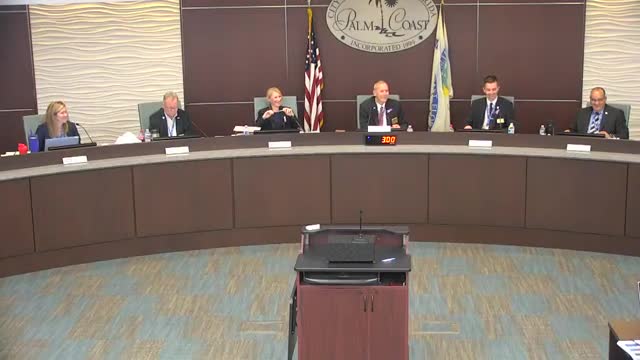City proposes bold public art funding initiative
October 17, 2024 | Palm Coast City, Flagler County, Florida
This article was created by AI summarizing key points discussed. AI makes mistakes, so for full details and context, please refer to the video of the full meeting. Please report any errors so we can fix them. Report an error »

During a recent city council meeting, officials discussed the introduction of an ordinance aimed at creating an \"Art in Public Places\" program, a key initiative for enhancing city beautification through public art. This proposal, presented by James Hurst from the Parks and Recreation Department, stems from a request made during an August workshop focused on arts, culture, and history programs.
The ordinance mandates that new private developments allocate 0.5% of their construction value towards public art or provide equivalent funds for its installation. This initiative is designed to integrate art into both public and private spaces, thereby enriching the community's cultural and aesthetic landscape.
Hurst emphasized the importance of the arts in contributing to the city's vitality, stating that the program would not only beautify the city but also support local artists and cultural initiatives. The proposed ordinance includes provisions for a public art fund, which would be used for the maintenance and upkeep of artworks, ensuring their preservation over time.
However, the proposal sparked a debate among council members. Some expressed concerns about the financial implications for developers and the potential for government-mandated art to be misaligned with community preferences. One council member voiced skepticism, recalling negative experiences from other cities where similar programs led to contentious outcomes regarding art selection.
In response, proponents of the ordinance argued that without such initiatives, funding for the arts would likely fall to taxpayers, a scenario they deemed undesirable given past failures in public fundraising for arts projects. The council ultimately decided to continue the discussion, with plans to review the full presentation and address concerns before moving forward with the ordinance.
The ordinance, if passed, would mark a significant step in the city's commitment to fostering a vibrant arts culture, while also raising questions about the balance between development and community expression.
The ordinance mandates that new private developments allocate 0.5% of their construction value towards public art or provide equivalent funds for its installation. This initiative is designed to integrate art into both public and private spaces, thereby enriching the community's cultural and aesthetic landscape.
Hurst emphasized the importance of the arts in contributing to the city's vitality, stating that the program would not only beautify the city but also support local artists and cultural initiatives. The proposed ordinance includes provisions for a public art fund, which would be used for the maintenance and upkeep of artworks, ensuring their preservation over time.
However, the proposal sparked a debate among council members. Some expressed concerns about the financial implications for developers and the potential for government-mandated art to be misaligned with community preferences. One council member voiced skepticism, recalling negative experiences from other cities where similar programs led to contentious outcomes regarding art selection.
In response, proponents of the ordinance argued that without such initiatives, funding for the arts would likely fall to taxpayers, a scenario they deemed undesirable given past failures in public fundraising for arts projects. The council ultimately decided to continue the discussion, with plans to review the full presentation and address concerns before moving forward with the ordinance.
The ordinance, if passed, would mark a significant step in the city's commitment to fostering a vibrant arts culture, while also raising questions about the balance between development and community expression.
View full meeting
This article is based on a recent meeting—watch the full video and explore the complete transcript for deeper insights into the discussion.
View full meeting